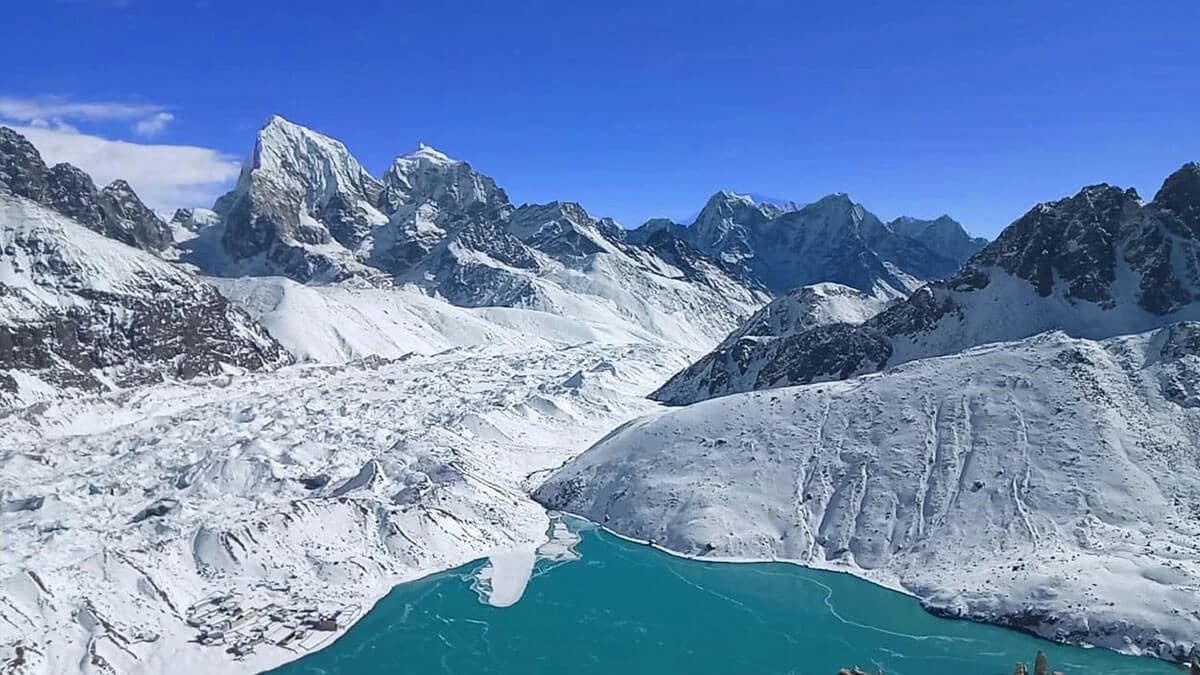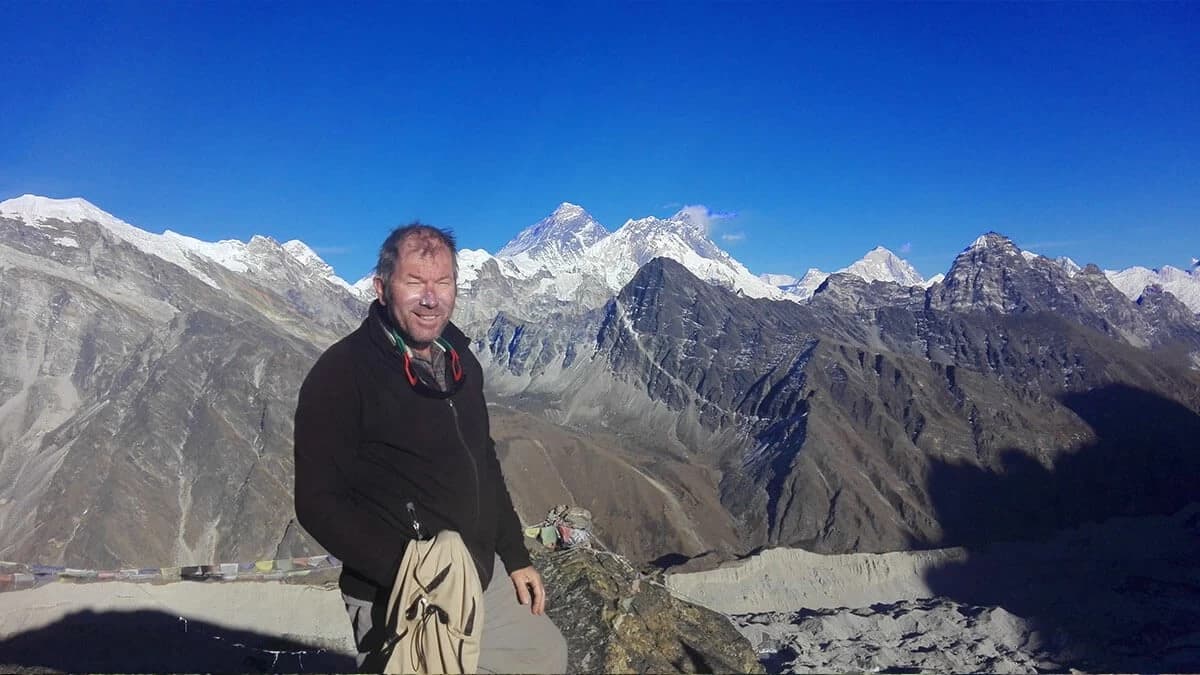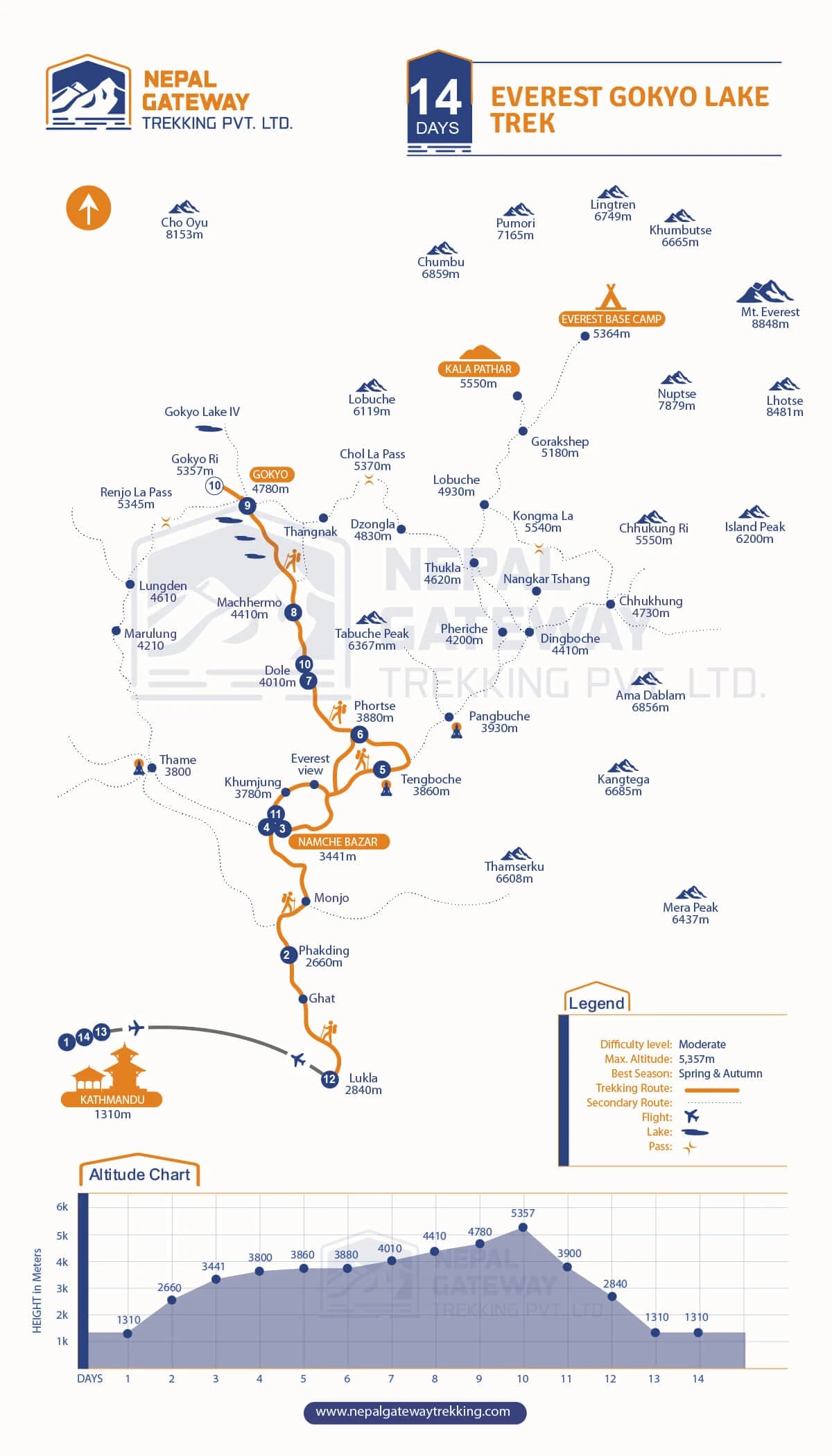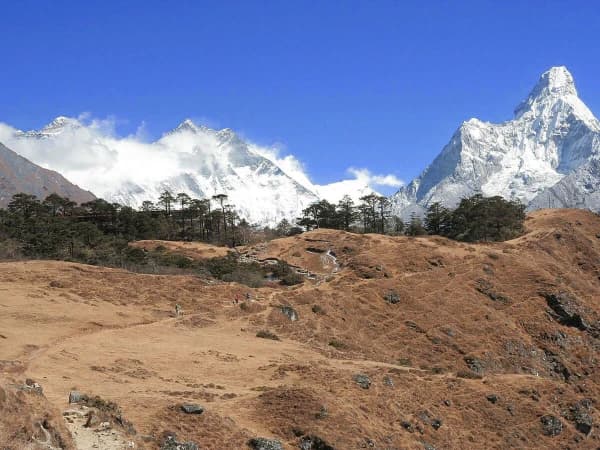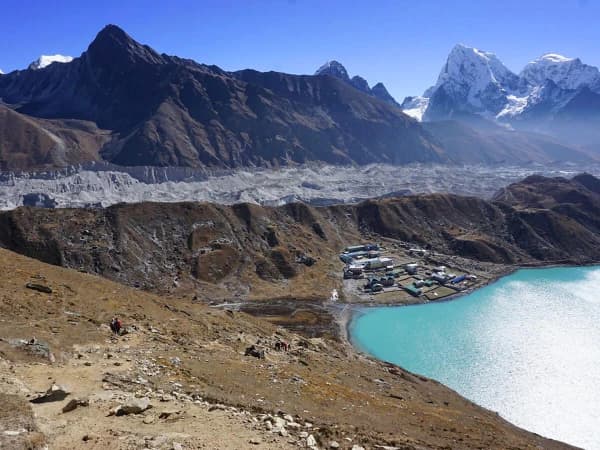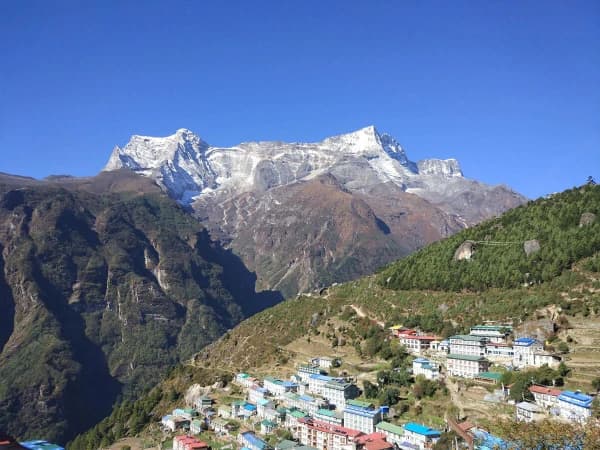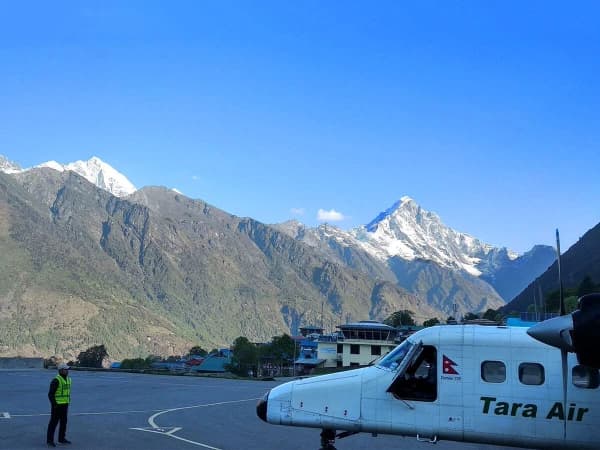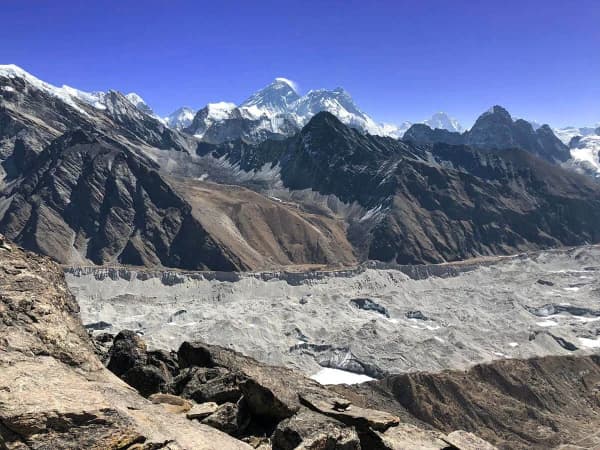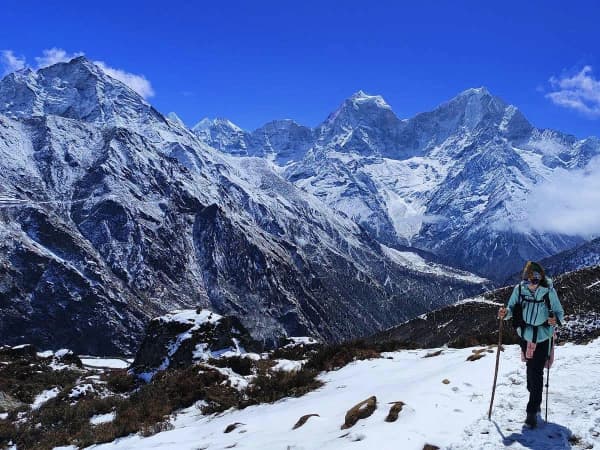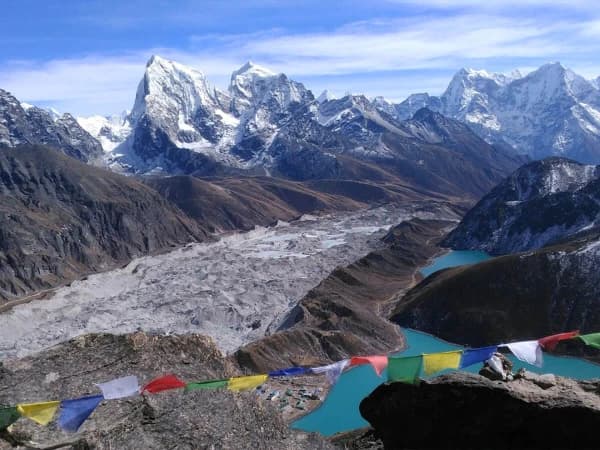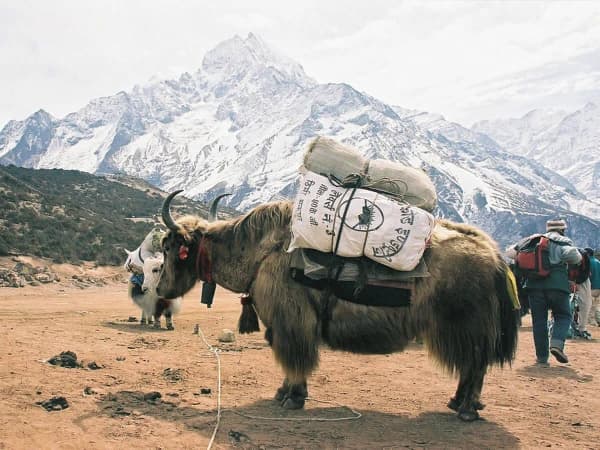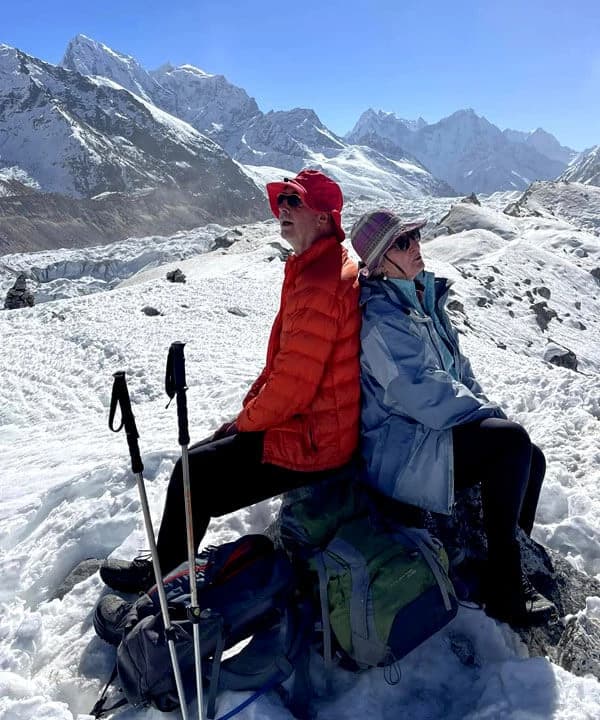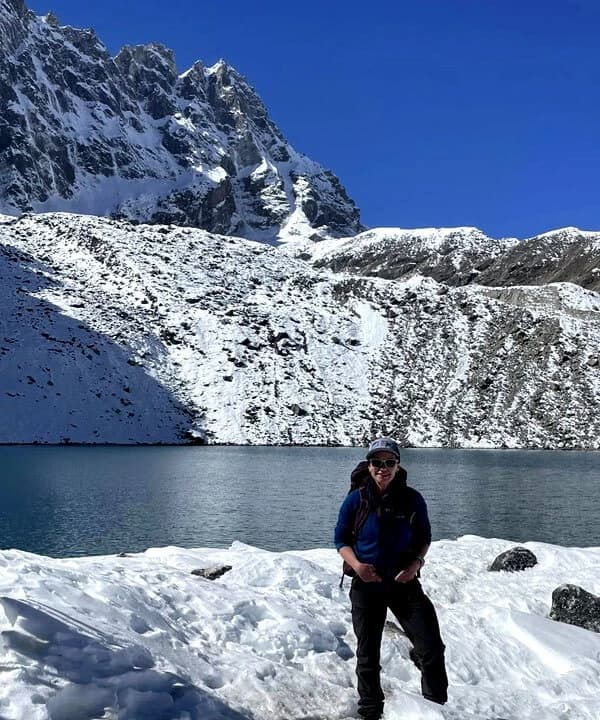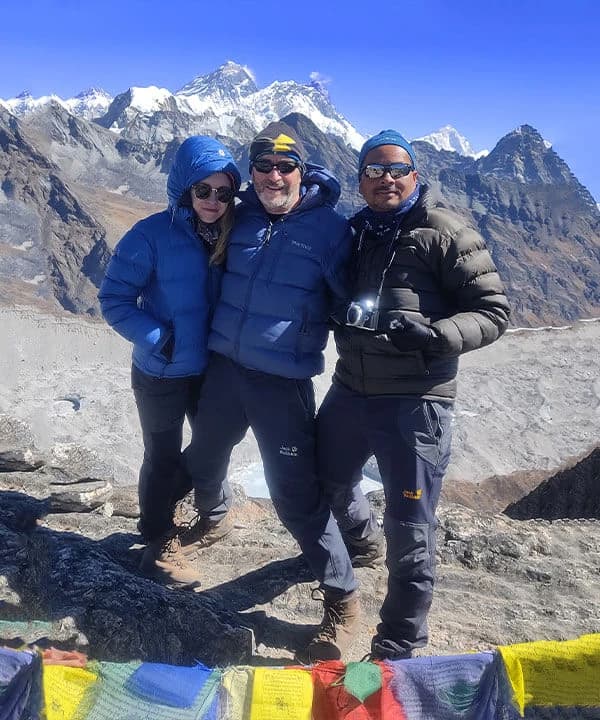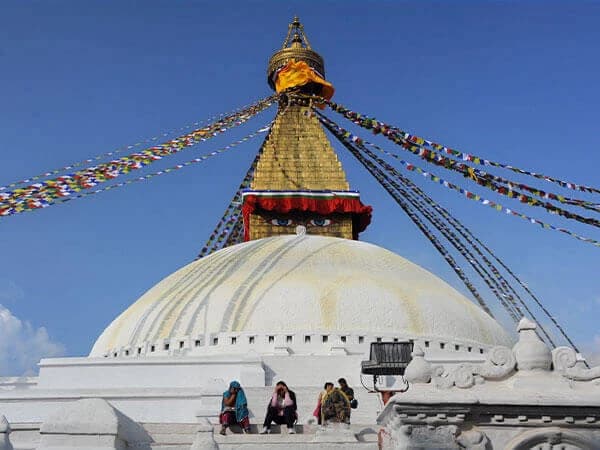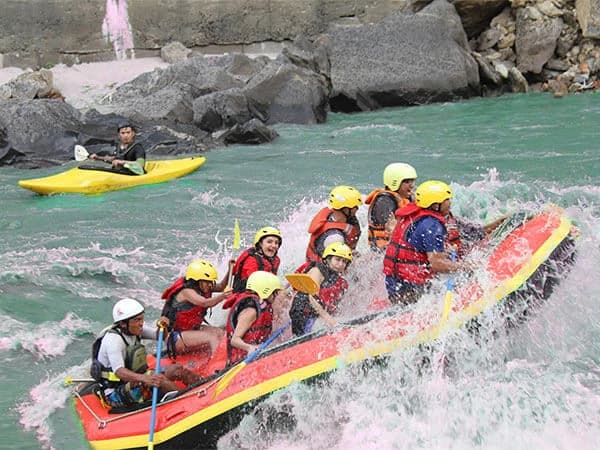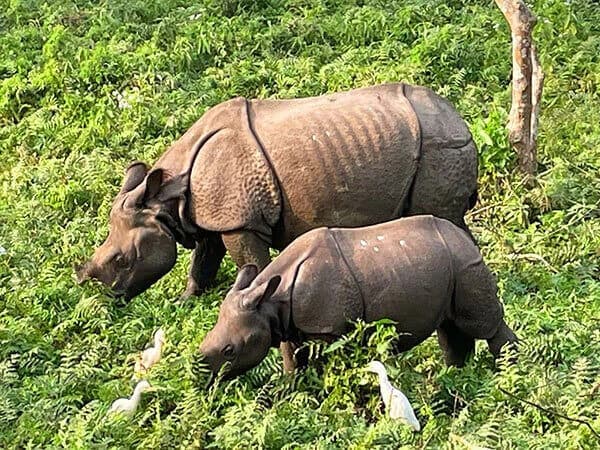Have you ever wondered what a lake looks like at 5,000 meters elevation? Our 14-day Everest Gokyo Lake Trek itinerary takes you to explore the Gokyo Lakes and their underrated beauty with Himalayan giants.
Everest Gokyo Lake Trek
Everest Gokyo Lakes trek is an excellent alternative to the traditional Everest Base Camp (EBC) trek in the Khumbu region of Nepal. The Gokyo trek route is famous for its splendid alpine lakes, quieter paths, and breathtaking towering peaks of the Everest region. The challenging Gokyo Ri peak provides sunrise panoramas with 360-degree mountain vistas, including four of the world’s tallest peaks: Everest, Lhotse, Makalu, and Cho Oyu.
The major highlight of the Everest Gokyo Lake trek itinerary features a chain of six glacial lakes, sacred to both Hindus and Buddhists, forming one of the world’s highest freshwater lake systems. Gokyo village, nestled beside the pristine lakes, offers authentic Sherpa culture and warm hospitality. The Gokyo route became increasingly popular as the EBC trail became overcrowded with hikers. Adventurers admire this hidden gem because of its peaceful atmosphere and awe-inspiring mountain scenery.
Gokyo Ri, or Gokyo Peak (5,357 m), quickly became famous for offering picture-perfect landscapes in the Everest region. The 14-day Gokyo Lake trekking package provides ample time to explore this magnificent trail. Today, the Gokyo trek is one of Nepal's most rewarding high-altitude adventures.
Sagarmatha National Park, a UNESCO World Heritage Site, is home to much flora and fauna. Rare species, including snow leopards, Himalayan black bears, and various colorful pheasants, inhabit this protected area. Likewise, the vegetation in this national park changes dramatically as elevation increases, transitioning from dense forests to stark alpine meadows. The park's ecosystem contains over 118 bird species and numerous endangered mammals. Thus, preserving the region's biodiversity for future generations is crucial.
The Gokyo Lakes trek provides a profound cultural experience deeply influenced by Tibetan-Buddhist traditions. Ancient monasteries dot the trail, where monks chant prayers and spin prayer wheels. The trek passes through Sherpa communities where traditional stone houses showcase centuries-old architecture. Local festivals and rituals reveal authentic Himalayan culture.
Important Note: During the peak season, flights will be operated from Manthali Airport, Ramechhap, to Lukla. In the spring, from mid-March to mid-May, and in the autumn, from late September to November, all flights take off and land at Manthali Airport.
The Manthali airport, Ramechhap, is 142 km from Kathmandu, a 4-5 hour drive. To catch a flight to Lukla from Ramechhap, you must depart from Kathmandu from 1 a.m. to 2 a.m.
We highly recommend that you come with at least one more extra day for jet lag, especially considering the early morning drive to Manthali Airport, which benefits from adequate rest and sleep beforehand.
The Major Highlights of Everest Gokyo Lakes Trek
- Enjoy the thrilling scenic flight to Lukla with spectacular Himalayan views.
- Explore Namche Bazaar, the bustling Sherpa capital and famous acclimatization stop.
- Visit Tengboche Monastery, the largest Buddhist monastery in the Khumbu region.
- Discover authentic Sherpa villages, including Phortse, Khumjung, and Khunde.
- Witness Nepal’s largest glacier, the massive Ngozumpa Glacier.
- Reach the pristine turquoise Gokyo Lakes at 4,790 meters.
- Conquer Gokyo Ri peak for sunrise views of four 8,000-meter giants.
- Cross the famous Hillary Bridge and other dramatic suspension bridges.
- Spot rare wildlife, including musk deer, Himalayan Tahr, and red pandas.
- Experience rich Sherpa culture through monasteries and traditional villages.
- Take acclimatization hikes to Hotel Everest View, the world’s highest hotel.
- Trek through diverse landscapes from forests to alpine meadows.
Gokyo Lake Trek Route Overview
The Everest Gokyo Lakes trek offers one of Nepal’s most spectacular Himalayan adventures, combining pristine alpine lakes with enticing Himalayan vistas. This incredible 14-day Gokyo Lake trekking package takes you through the heart of Sherpa country to reach the world’s highest freshwater lake system.
The Gokyo Lake trek route starts in Lukla. It follows ancient trading paths through traditional hamlets, dense forests, and high alpine valleys. The journey provides an exceptional alternative to the crowded EBC trek while offering equally jaw-dropping mountain panoramas.
Your Gokyo adventure begins with a thrilling flight to Lukla, followed by gentle acclimatization days through Phakding and Namche Bazaar. The EBC trail leads you through the bustling Sherpa capital before branching toward the cultural highlight of Tengboche Monastery.
From Tengboche, the Gokyo trail diverges through the quaint village of Phortse, offering authentic mountain culture away from the busy EBC trek crowds. This more tranquil route facilitates more intimate traditional Sherpa communities and enhanced wildlife witnessing.
The highlight of the Gokyo Lake trek itinerary unfolds as you enter the magnificent Gokyo Valley, home to six pristine turquoise lakes. Trekking to Gokyo Valley in Nepal reveals some of Earth's most stunning glacial landscapes, with the massive Ngozumpa Glacier creating a dramatic backdrop.
Next, the trail gradually ascends through alpine meadows and yak pastures, passing the first two lakes before reaching the main Gokyo Lake at 4,790 meters. This holy lake, surrounded by tall peaks, represents the spiritual heart of the entire trip.
Hiking to Gokyo Lakes reaches its climax with the pre-dawn ascent of Gokyo Ri peak at 5,357 meters. This demanding ascent rewards trekkers with one of the most spectacular 360-degree panoramas in the Himalayas, featuring four 8,000-meter giants: Everest, Lhotse, Makalu, and Cho Oyu.
Nonetheless, the sunrise views over the lake and surrounding glaciers create unforgettable photographic opportunities. This moment alone justifies choosing the Gokyo Lake trekking over other mountain adventures in the region.
The 14-day Gokyo Lake trek package includes strategic acclimatization stops and cultural exploration through traditional hamlets like Khumjung and Khunde. The return journey offers fresh perspectives on familiar Everest landscapes while descending through rhododendron forests and crossing iconic suspension bridges.
After getting back to Lukla, you'll fly back to Kathmandu. With the final departure, the Gokyo trip concludes with outstanding achievement and a deep connection to one of Earth’s most magnificent mountain regions.
Why Choose Nepal Gateway Trekking for the Everest Gokyo Lake Trekking?
- Expert Experience & Local Knowledge: We have been working in the Everest region for many years. Our veteran guides know the area well and have led many successful treks. They handle crises and provide the most valuable local insights for your trip.
- Transparent Pricing with No Hidden Costs: Our prices are transparent and fair. We list what’s included: permits, flights, accommodation, porter services, meals, gear, and emergency support. You get great value with no surprise fees.
- Flexible Trip Planning: We customize trips to fit your needs. You can add extra rest days, include special passes like Renjo La, adjust trip length, and plan accordingly to your fitness level and interests.
- Strong Safety Measures: Your safety comes first. We monitor altitude levels, provide first-aid-trained guides, carry emergency communication equipment, and have quick access to rescue services when needed.
- Responsible Tourism: We care about the environment and local communities. We hire local staff, support Sherpa families, follow eco-friendly practices, and manage waste properly to protect the mountains.
- Quick Personal Service: We respond to your questions fast. Our team gives personal attention to each traveler and helps with all your planning needs from start to finish.
- Complete Trip Solution: We handle everything for you. From travel insurance advice and airport pickup to trek completion, you get a one-stop service that covers all your needs.
Itinerary
This is our standard and recommended itinerary for the Everest Gokyo Lake Trek.
A friendly representative from Nepal Gateway Trekking will be waiting to welcome you at Kathmandu International Airport. After clearing immigration, enjoy a comfortable ride to the hotel. You can relax, freshen up, and rest before the trek briefing.
This essential briefing covers the complete Gokyo Lake trek plan, checks your packing list, and shares valuable tips for the journey ahead. You'll have a chance to ask questions and feel well-prepared. Afterward, wander through the lively streets of Thamel filled with restaurants, cafes, and trekking shops.
Pick up any last-minute gear or simply enjoy the vibe. Return to the hotel early to rest and prepare for tomorrow’s departure.
Prepare for a short flight to Lukla by rising early and driving to the airport. This thrilling 35-minute journey rewards with impressive views of Kathmandu valley, terraced fields, and rolling green hills. As you approach Lukla’s famous runway, snow-capped peaks fill the horizon.
When you get to Lukla airport, meet your experienced crew and officially begin your Everest Gokyo trek toward Phakding. This pleasant first day is a perfect warm-up for the challenging trekking days ahead. The well-marked trail descends gently through the heart of Sherpa country, passing traditional hamlets like Chheplung and Ghat.
Phakding is the perfect place to spend the first night on the EBC route. This lovely village is next to the rushing Dudh Koshi River and has comfortable lodges and astonishing mountain vistas. The day’s easy trek allows your body to adjust gradually while soaking in the rich Sherpa culture, prayer wheels, and colorful prayer flags that line the track.
Important Note: During the peak season, flights will be operated from Manthali Airport, Ramechhap, to Lukla. In the spring, from mid-March to mid-May and late September to November in the autumn season, all flights take off and land at Manthali Airport.
The Manthali airport, Ramechhap, is 142 km from Kathmandu, a 4-5 hour drive. To catch a flight to Lukla from Ramechhap, you must depart around 1 a.m. to 2 a.m. from Kathmandu.
Begin your second day on the Gokyo trek route after a hearty breakfast in Phakding. The trail follows the Dudh Koshi River through beautiful pine forests and busy pathways filled with fellow trekkers. You’ll share the route with caravans of yaks and donkeys carrying supplies, crossing several suspension bridges, including the notable Hillary Bridge.
The course goes through towns like Bengkar and Monjo, where you’ll enter Sagarmatha National Park and have your permits checked. When you get to Jorsalle village, prepare for the most challenging trek: the climb from Larja Dovan to Namche Bazaar. This steep uphill climb tests your endurance significantly compared to yesterday’s gentle walk, marking a real step up in difficulty and altitude gain.
Midway through the demanding climb, pause to catch your first eye-popping glimpse of Mt. Everest towering above the surrounding peaks. Namche Bazaar is the bustling Sherpa capital and the largest town in the region. You get there after signing in at the last checkpoint. This famous acclimatization stop is ideal for both EBC and Gokyo trekkers to rest and acclimate to the higher altitude before moving ahead.
Today marks your first acclimatization day in Namche Bazaar during the Gokyo Lakes trekking adventure. Rest doesn’t mean staying idle at your teahouse—you must take an acclimatization Namche hike to help your body adjust properly. Choose between short and long hiking options based on your energy levels and health conditions.
The most popular side trip is hiking to Hotel Everest View, the world’s highest hotel at 13,000 feet. This hotel offers a captivating 360-degree view of Everest, Lhotse, and Ama Dablam. Back in Namche, you can explore local attractions like Namche Monastery, the Sherpa Cultural Museum, and Sagarmatha National Park Museum to learn about the region’s rich heritage and mountain history.
After your acclimatization day in Namche Bazaar, continue your journey with refreshed energy and better altitude adjustment. The trail begins with relatively flat, easy walking that gradually opens sweeping views of the magnificent Ama Dablam peak. Pass through charming Sherpa settlements like Sansa and Kyangjuma, where traditional tea houses offer warm hospitality.
The path then descends through spectacular forested sections dotted with prayer wheels, mani stones, and several suspension bridges. Cross the impressive high bridge at Phunki Tenga before facing the day’s primary challenge– a steady, steep ascent through dense rhododendron forest. This demanding final climb tests your endurance but rewards you with sublime views of Mt. Everest, Lhotse, Nuptse, and Thamserku peaks.
Arrive at Tengboche village, perfectly positioned at the confluence of two valleys where the Dudh Koshi and Imja River meet. The cultural highlight of the Gokyo trek is visiting Tengboche Monastery, the largest in the Khumbu region. The monastery comes alive during the Mani Rimdu Festival in October or November, making it a spiritual stop.
Leave Tengboche behind and take a peaceful detour off the busy Everest Base Camp trail toward Phortse village. This quieter alternative route offers a more serene walking experience away from the crowds of trekkers. The trail winds through luscious rhododendron forests, fir, birch, and juniper trees, creating a natural canopy above your path.
Arrive at Phortse, a traditional Sherpa settlement perched dramatically high on a hillside above the rushing Dudh Koshi River. This authentic settlement remains far less commercial than the main Everest route. Stone houses with colorful prayer flags, well-kept farms, and a small monastery give it an authentic mountain charm.
The main Gokyo path begins today from Phortse. The path starts immediately out of Phortse with a steady uphill climb through lush forests and cascading waterfalls. Stone benches along the way provide perfect rest spots as you gain altitude through this beautiful wilderness.
Watch the terrain transform dramatically as you ascend higher on the Gokyo trail. Dense, mossy paths with birch and rhododendron trees gradually give way to windblown alpine slopes. Magnificent panoramas of Cho Oyu and Thamserku peaks unfold before you. At the same time, the deep valley below Phortse creates a breathtaking backdrop for your journey.
Keep your eyes open for unlikely wildlife sightings, including Himalayan Tahr, musk deer, and, if you’re fortunate, the elusive red panda or snow leopard. You reach Dole, a small hamlet surrounded by yak pastures and alpine meadows. This quiet settlement has cozy lodges where you can rest while enjoying the crisp mountain air and watching yaks grazing.
Begin your day with a brief steep climb out of Dole before the path settles into a gentle ascent along the Gokyo route. The trail follows the hillside high above the Dudh Koshi River, with the deep valley stretching far below. Since you’re now in high alpine terrain, most of the trek unfolds above the tree line under vast open skies.
The trail is blessed with panoramic vistas of towering Himalayan peaks, especially the imposing Cho Oyu, the world’s 6th highest mountain. Thamserku, Kangtega, Taweche, and Taboche create an eye-opening backdrop as you walk towards the Gokyo Valley. The scenery changes from low bushes to open alpine meadows and yak pastures. If lucky, you might see mountain goats and musk deer grazing nearby.
Pass through some still settlements, including Luza and Lhabarma, before reaching Machhermo village. This small, tranquil settlement serves as an essential acclimatization stop. A Himalayan Rescue Association post provides valuable information on altitude sickness prevention. The relatively short trekking day allows you to rest, acclimatize properly, and soak in the spiritual stillness of these magnificent mountains.
Today brings the major highlight of the Gokyo Valley trek itinerary—the pristine Gokyo Lakes. Leave Macchermo behind and steadily climb the exposed Gokyo Valley trail above the Dudh Koshi River. Giant peaks dominate the skyline, while sublime views of Nepal’s largest glacier, Ngozumpa Glacier, create a truly wild glacial landscape ahead.
As you enter the magnificent Gokyo Valley, pass by the first two pristine lakes—Longponga and Taujung Tsho. Continue the Gokyo trek route to reach the third largest lake, Gokyo Lake (Dudh Pokhari), at an impressive 4,790 meters. The ethereal turquoise-blue waters, surrounded by dramatic peaks and glacial backdrops, create one of the most alluring Himalaya sights.
Arrive at Gokyo village, a small hamlet of stone lodges positioned perfectly beside the shimmering lake shores. This peaceful settlement is the base for exploring Gokyo Ri and the upper lakes. It's also a good place to adjust to the altitude before tackling high passes like Renjo La and Cho La.
Start your pre-dawn hike from Gokyo to catch the magnificent sunrise from Gokyo Ri summit. The steep, rocky trail is well-marked and safe, gaining about 560 meters in elevation from the village. This challenging Gokyo Lake hike rewards you with one of the most majestic 360° views in the Himalayas, featuring four towering 8,000-meter peaks: Mt. Everest, Lhotse, Makalu, and Cho Oyu.
From the summit, witness the startling panorama of the entire Gokyo Valley, shimmering Gokyo Lakes, and massive Ngozumpa Glacier spread below. Morning sunlight bathes the pristine lakes and snow-capped peaks in golden and pink hues, creating unforgettable photography opportunities. The astounding scenery makes every step of this demanding climb absolutely worthwhile for any Gokyo trekking adventure.
After descending to Gokyo village for breakfast, begin your journey back down the valley toward Dole. The path retraced the steps through the scenic landscapes, offering fresh perspectives as you descend past Machhermo and Luza. Moving from high alpine meadows back into yak pastures and rhododendron forests, you’ll appreciate having trekking poles for the knee-jarring descent.
Arrive at Dole with a tremendous sense of achievement from your successful trek to Gokyo Valley and conquering Gokyo Ri peak.
Begin the descent from Dole through lovely pine, birch, and rhododendron forests. The trail gradually transitions into lush green landscapes while you cross suspension bridges and pass through peaceful yak pastures. Cross the scenic Mong La ridge, a popular point for panoramic views and photos of valleys and surrounding Himalayan peaks.
After Kyanjuma, branch off from the main Everest trail toward the traditional twin hamlets of Khumjung and Khunde. Khumjung lies below the sacred Khumbila peak, with green-roofed stone houses and a centuries-old monastery known for the “Yeti Scalp”. You can also visit the Hillary School, founded by Sir Edmund Hillary to give local children a better education, showing how mountaineering changed life here.
A short walk from Khumjung is Khunde, home to the Hillary Hospital, which serves people across the Khumbu region. Both settlements offer a closer look at Sherpa life, far from the busy trekking routes. After explorations, follow the downhill forest paths and stone trails back to Namche Bazaar.
Enjoy a pleasant downhill walk back to Lukla on the final day of your Everest Gokyo Lakes trek. The trail goes through familiar territory, transitioning from high Sherpa settlements to greener forests along the lively Dudh Koshi River. Relish the distant snow-capped peaks one last time and revisit memorable sights from an entirely new perspective after your great mountain adventure.
Cross the impressive Hillary suspension bridge, which spans deep gorges and rushing rivers below. The core of the Sherpa community is defined by traditional chortens, colorful mani walls, spinning prayer wheels, and authentic stone houses. The course passes through charming hamlets like Jorsalle, Monjo, Phakding, Chumoa, and Benkar. Your remarkable Gokyo trek concludes in the lively town of Lukla.
Conclude your memorable 14-day Gokyo trek with an early morning flight from Lukla back to Kathmandu. After takeoff, enjoy staggering aerial views of the towering peaks, deep river valleys, terraced hillsides, and remote settlements you’ve walked through. If weather conditions are clear, catch a bird's-eye glimpse of iconic Himalayan giants– a perfect farewell to some of the world’s tallest mountains.
This scenic 35-minute flight provides the perfect opportunity to reflect on your wondrous trekking achievements during the Gokyo trek. As you return to the capital city, you can see Kathmandu’s sprawling valley again. Spend the final evening in the town, refreshing, relaxing, and exploring Thamel's lively streets and markets.
Today marks the end of an incredible Everest Gokyo Lakes trek adventure in Nepal. If your flight is later, you can wander Thamel's markets, pick up a few souvenirs, and take home some authentic Nepali handicrafts.
The Nepal Gateway Trekking will ensure a smooth transfer to Kathmandu International Airport for your departure home. As you head home, carry the memories of pristine turquoise lakes, towering peaks, and warm Sherpa hospitality. We'll welcome you back whenever you wish to explore Nepal, Bhutan, or Tibet again.
Dates & Availability
Private tripCost Includes
- All ground transportation as per itinerary.
- Two nights’ accommodation at a three-star category hotel in Kathmandu, inclusive of breakfast.
- Round-trip flight ticket (Kathmandu/Lukla/Kathmandu or Ramechhap/Lukla/Ramechhap) inclusive of domestic airport taxes.
- Three meals (breakfast, lunch, and dinner) in the trek
- Twin-sharing common room accommodations during the trekking.
- One highly experienced English-speaking & friendly trekking guide.
- Required porters (one porter between two trekkers). A porter is not included for solo trekkers.
- Sagarmatha National Park permit and TIMS card.
- Everest Gokyo Lake Trek map.
- Nepal Gateway Company T-Shirt.
- Complimentary Nepal Gateway duffel bags for trekking.
- Local fresh fruits (apples, oranges, pomegranates, etc.).
- First aid kit with oximeter to check client's oxygen level and heartbeat regularly.
- Evacuation assistance if it is necessary during the Gokyo Lake Trek.
- Government taxes and VAT.
- Office service charge.
Cost Excludes
- Lunches and dinners in Kathmandu.
- Your medical travel insurance.
- Nepal Visa.
- Your international flight ticket to/from Kathmandu.
- All kinds of hot drinks, such as teas, coffees, and hot waters, during the trek.
- Cold drinks (mineral waters, Coke, and Fanta) and alcoholic beverages on trekking.
- Your personal nature expenses, equipment, and medical kit.
- Hot shower, internet, and phone call unless it is free.
- Snacks and desserts (apple pie, cakes, chocolates, etc.).
- Tipping to field staff (tipping is not mandatory but expected).
Good To Know
Everest Gokyo Lakes Trek Cost
The Everest Gokyo Lakes trek cost typically ranges from USD 1340 to USD 1190 per person for a standard 14-day package in 2025. The Gokyo Lake trek package cost includes domestic round-trip flights from Kathmandu to Lukla, all necessary permits, and full board accommodation in tea houses.
The guided package prices for Gokyo trekking also cover three meals daily, professional licensed guide and porter services, airport transfers, and three nights' hotel stay in Kathmandu. Additional inclusions are trekking maps and basic first aid supplies.
The price for trekking to Gokyo Valley varies depending on the season and group size. During peak trekking seasons (March-May and September-November), the cost of trekking to Gokyo Lake increases slightly due to higher demand. Off-season treks in winter and summer months offer lower prices. Discounted rates are available for large groups.
There is an option of luxury packages with private rooms, upgraded hotels, and helicopter flights, which cost more. Premium Gokyo Lake package options enhance comfort for those willing to pay higher prices.
Combined trekking routes significantly impact the overall expense. The Everest base camp via EBC cost increases when you combine Gokyo Lakes with Everest Base Camp or Cho La Pass routes. These extended itineraries add trekking days and highlights of the Everest region.
The longer duration means higher accommodation, guide, and porter costs. Such combination packages offer better value for trekkers exploring multiple destinations in one trip.
Several expenses remain excluded from the standard package cost. International airfare to and from Nepal, visa fees, personal travel insurance, and meals in Kathmandu are not included. Mountain lodge extras like hot showers, Wi-Fi, and bottled drinks require separate payment.
Budget additional funds for guide and porter tips, gear purchase or rental, and emergency expenses. Weather delays at Lukla airport and unexpected situations may require extra spending during the trek.
Best Time for Trek to Gokyo Lakes
The best season to trek to Gokyo Lakes falls into two prime seasons: spring (March to May) and autumn (September to November). The weather is most inviting, mountain sights are crystal clear, and trail conditions are more manageable during these periods.
While trekking to Gokyo Valley is possible year-round, the best time for the Gokyo Lakes trek provides optimal safety and scenic beauty. Winter and summer treks present significant challenges but can reward experienced trekkers with unique experiences.
The spring season stands out as the best time to visit Gokyo Lake for many trekkers. The Gokyo trails have vibrant rhododendron and blooming flowers, creating a colorful landscape. Gokyo Lakes weather during spring offers pleasant daytime temperatures of 10-20°C at lower elevations and 0-10°C at higher altitudes. Clear skies provide crisp mountain vistas, though nights near Gokyo Valley can be cold.
Autumn is another prime time for the Gokyo trek, with ideal weather following the monsoon season. The dry trails and clear skies offer unobstructed sights of Mt. Everest, Lhotse, Cho Oyu, and Makalu from Gokyo Ri.
This season provides perfect opportunities for photography enthusiasts seeking terrific mountain vistas. Gokyo Valley weather remains comfortable, with temperatures ranging from 10 to 20°C at lower elevations and moderate conditions at higher altitudes.
Summer and winter present challenging alternatives for trekking to Gokyo Lakes. The summer monsoon brings heavy rainfall, limited mountain vistas, and slippery trails with swollen streams. Nonetheless, you’ll encounter fewer tourists and verdant landscapes.
It's very cold and snowy in the winter, with limited teahouses. However, the snow-capped peaks and peaceful pathways are so magnificent during winter. These off-season treks require proper gear, extensive planning, and significant trekking experience to withstand Gokyo's weather conditions.
Everest Gokyo Lakes Trekking Permits
The Everest Gokyo Lake trek permits are similar to Everest Base Camp trekking permits and are mandatory for all trekkers. You need two permits for trekking to Gokyo Valley. The first is the Sagarmatha National Park Entry Permit, which costs approximately $25 (NPR 3,000). You can obtain this permit at the Nepal Tourism Board in Kathmandu or at Monjo's park entrance.
The second required Gokyo Lake trek permit is the Khumbu Pasang Lhamu Rural Municipality Permit, costing around $25 (NPR 3,000). This permit is issued at Lukla airport or designated checkpoints along the trail. This permit was recently introduced asrequirement for all trekkers in the Everest region.
When you book with Nepal Gateway Trekking, we handle all Everest Gokyo Lake trek permits on your behalf. We update our clients about local rules or permit fee changes to ensure a smooth trekking experience.
Difficulty Level of Everest Gokyo Lakes Trek
The difficulty level of the Everest Gokyo Lake trek is moderately challenging for most people. Over 14 days, you'll cover about 100 kilometers of rugged terrain, walking 9-10 kilometers daily, around 6-7 hours. The Gokyo Lakes trek difficulty escalates due to the distance and the number of trekking days.
The Gokyo trek route features steep uphill and downhill segments that test physical endurance. These challenging sections demand good fitness levels and proper preparation. The Gokyo trail includes rocky paths, moraines, and glacier crossings. Steep ascents and descents make this trek more demanding than basic mountain walks. Strong legs and cardiovascular fitness are essential for conquering these terrain challenges.
The Gokyo trek altitude presents the biggest challenge for most trekkers. The Gokyo Lakes trek height ranges from 4,700 meters to 5,000 meters above sea level. High altitude brings serious risks of altitude sickness and breathing difficulties. Proper acclimatization days are crucial for safe completion. The thin air at these elevations makes every step more exhausting than at lower altitudes.
Weather conditions along the Gokyo trail add another layer of difficulty. While the lower hamlets are relatively warm, the higher elevations can be bitterly cold, with freezing winds and sudden changes in conditions. Choosing the right season significantly reduces the Gokyo Lakes trek difficulty. With the most consistent weather, Spring and autumn are the best times for this challenging Himalayan adventure.
Training for Trekking to Gokyo Lakes
High-altitude trekking above 2,500 meters requires serious preparation and commitment. Training for the Everest Gokyo Lake trek is essential for a successful and enjoyable journey. The fitter you are before starting, the more you’ll appreciate the phenomenal mountain scenery. Without proper preparation, you’ll spend your energy surviving each day instead of enjoying the hiking.
You can begin Gokyo trek preparation by building strong cardiovascular fitness. Walking, jogging, running, cycling, and swimming are excellent exercises. Start your training routine at least 3-4 months before your Nepal trekking adventure. This timeline helps your body adapt gradually to increased physical demands. Regular cardio workout improves your endurance and oxygen efficiency at high altitudes.
Similarly, the Gokyo trekking route requires strong core muscles in your legs, arms, and back. You’ll carry a heavy backpack for long hours on steep terrain. Do push-ups, planks, squats, and pull-ups to build overall strength. Pay special attention to knee and ankle strength for uphill and downhill sections. Regular hiking practice is the best way to enhance stamina and prepare for trekking conditions.
Mental preparation for the Gokyo Valley trek is equally important as physical training. You need mental strength to complete this challenging high-altitude journey. Practice staying focuses and flexible when facing unexpected situations. Remote mountain conditions require adaptability and patience.
Daily yoga and meditation help build mental resilience and a positive attitude. A strong mind enables you to overcome physical challenges and enjoy the entire trekking experience.
Altitude Sickness During Everest Gokyo Lakes Trekking
Altitude sickness during Everest Gokyo Lakes trek is a serious concern that affects many trekkers. The trip begins with a flight from Kathmandu (1,400m) to Lukla (2,880m), followed by trekking to Namche Bazaar (3,440m) within just a few days. This rapid altitude gain makes it difficult for trekkers to adapt to the reduced oxygen levels at high elevations. The risk of altitude sickness on Gokyo Lake trek increases significantly as you ascend higher along the Gokyo trail.
Acute Mountain Sickness (AMS) has various symptoms, including nausea, insomnia, diarrhea, headaches, and loss of appetite. If you neglect this condition, it might become life-threatening. If symptoms persist or worsen, first descend immediately.
If things don't improve, you may need to abandon the trek entirely. At high altitudes, the oxygen levels are lower, making breathing difficult. Your body requires time to adjust to these difficult circumstances.
The best way to prevent altitude sickness during Gokyo Lake trek is through proper preparation and following safety guidelines. Essential preventive measures include:
- Drink plenty of water throughout the day to maintain adequate hydration.
- Eliminate alcohol and caffeinated drinks that cause dehydration.
- Don't rush; maintain a slow and steady pace.
- Ascend no more than 300 meters daily, especially above 2,500 meters.
- Include proper acclimatization days in the itinerary.
- Get a medical check-up before the trek and discuss altitude sickness prevention.
- Never attempt to treat symptoms yourself, as it may lead to dangerous complications.
- Pay attention to early warning signs and act immediately.
Travel Insurance for trek to Everest Gokyo Lake
Travel insurance for Everest Gokyo Lakes trek is necessary and often mandatory. The trek reaches elevations above 5,000 meters, exposing trekkers to serious altitude sickness risks that can be life-threatening. The Everest Gokyo Lakes region has extremely limited medical facilities with only basic treatment options. Emergency helicopter evacuation is the only viable alternative for treating serious illnesses or injuries.
The cost of an emergency helicopter evacuation in the Himalayas can range from USD 5,000 to 10,000, so it's essential to have full coverage. In this remote part of the Himalayas, bad weather often causes flight delays and cancellations, meaning you might have to pay for extra meals and lodging.
Additionally, a good insurance plan for treks like the Gokyo trek should cover lost or damaged gear, as equipment failure in harsh mountain conditions can be costly and dangerous. Therefore, ensure your insurance policy meets all required standards for high-altitude adventures. Your coverage must include:
- Minimum altitude coverage up to 5,600 meters (altitude of Gokyo Ri).
- Comprehensive emergency helicopter evacuation coverage.
- Medical treatment coverage for altitude sickness and mountain-related injuries.
- Protection against weather delays and cancellations.
- Coverage for lost, stolen, or damaged trekking equipment.
- Carefully review terms regarding extreme activities and Himalayan-specific risks.
Route Variations in Gokyo Lakes Trek
The standard Everest Gokyo Lakes trek offers superb mountain scenery and pristine alpine lakes. However, several route variations for the Gokyo Lakes trek add extra trekking days with a unique experience and challenges. These alternative routes let you discover the Everest region's diverse landscapes and cultures.
Gokyo Lakes with Renjo La Pass Trek
The Gokyo Lakes with Renjo La Pass trek offers an astonishing alternative return route. Instead of heading back the same way, you'll cross the famous Renjo La Pass from Gokyo village. This pass provides striking panoramic Himalayan scenes, including Everest and surrounding peaks. The route then descends to traditional Sherpa villages like Thame, which remains less crowded than other areas. Finally, you complete the rewarding circuit at Namche Bazaar.
Gokyo Lakes and Everest Base Camp via Cho La Pass Trek
This challenging route variation combines two iconic destinations in a single journey. The itinerary is the same till Gokyo Lakes, after climbing Gokyo Ri, you cross the demanding Cho La Pass. This high-altitude pass links the Gokyo Valley with the classic Everest Base Camp trail at Lobuche. The hike continues to Everest Base Camp and Kala Patthar for glorious sunrise views. The return trip goes through Pheriche, Namche, and Lukla, as the usual EBC route.
The Everest Three Passes Trek
The Everest Three Passes trek represents the ultimate Everest region adventure. This comprehensive circuit crosses all three major passes: Kongma La, Cho La, and Renjo La. The route covers Gokyo Lakes, Everest Base Camp, and Kala Patthar in one complete loop. This is the most challenging and demanding trek in the region. However, it rewards trekkers with the Everest region's most diverse landscapes and experiences.
Side Trips and Gokyo Lake Exploration
Extended side trips and Gokyo Lakes exploration add extra adventure to your itinerary. You can visit the remote 4th, 5th, and 6th Gokyo Lakes beyond the standard route. A challenging day hike up the Ngozumpa Glacier provides access to a pristine wilderness area. These trails don't get many visitors, offering complete solitude and untouched natural beauty. The extra exploration days give many chances to take pictures and let you go deeper into the mountains.
Everest Gokyo Lakes Trek from Salleri/Jiri
The Everest Gokyo Lakes trek from Salleri/Jiri starts from alternative trailheads in the lower hills. This variation adds extra days of hiking and facilitates better acclimatization and deeper cultural immersion in local communities. The route avoids unpredictable Lukla flights while offering a more gradual approach. After joining the main trail at Lukla, the itinerary follows the standard Everest Gokyo Lake trek route.
Accommodation on the Everest Gokyo Lake Trek
Accommodation on Gokyo Lake trek is more basic and limited than the Everest base camp trekking accommodation. However, you’ll find adequate accommodation options in villages like Dole, Machhermo, and Gokyo. Most accommodations are teahouses, basic lodges, and hotels run by local families. These teahouses typically offer twin beds, mattresses, pillows, and bed sheets with minimal furniture for your belongings.
Up to Namche Bazaar, teahouses provide better amenities, including spacious rooms with attached bathrooms and shower facilities. Some teahouses offer electric heating systems for an additional fee. Beyond Namche on the isolated Gokyo trail, you’ll encounter fewer teahouses with more basic facilities. Most have shared bathroom and shower facilities, and hot showers come with a fee. For hygiene purposes, you must bring hand sanitizer and toilet paper.
Once you reach Gokyo Valley, the number of teahouses increases significantly. Some well-regarded lodges offer comfortable accommodation that’s considered luxury by regional standards. These lodges provide higher comfort levels with en-suite bathrooms, hot showers, spacious rooms, and comfy beds. All teahouses feature communal dining areas with heating systems (usually wood-burning stoves) where trekkers gather for meals and socializing.
Overall, finding accommodation during the Gokyo Lakes trek is manageable, even though the trail is less developed than the main EBC route. However, during peak trekking seasons in Nepal, booking your accommodation in advance is best to ensure you get a room along the way.
Food and Drinks on Gokyo Lakes Trek Route
Food along the Everest Gokyo Lake trek is served in teahouses throughout the Gokyo trek route. Like most tea house treks in Nepal, you’ll have breakfast and dinner at your overnight teahouse accommodation. Lunch is typically taken at teahouses located midway along the daily trekking route. The Gokyo route offers plenty of food and drink options to keep trekkers well-nourished during their journey.
Dal Bhat, a staple Nepalese dish, is the most popular meal among Gokyo trekkers. This traditional Nepali dish provides excellent energy for hiking in Nepal trekking routes. This meal includes steamed rice, lentil soup, vegetable curry, pickle, salad, and optional non-vegetarian items. Dal Bhat is commonly served for lunch and dinner due to its nutritional value and energy-boosting properties.
You’ll find local and western-style options along the trail for breakfast. You'll get Tibetan bread with honey, jam, peanut butter, Tsampa pride, oatmeal, and cornflakes. Various egg preparations are also available, like boiled, scrambled, fried, or omelet. For lunch and dinner alternatives to dal bhat, teahouses offer soup noodles, pizza, Sherpa stew, macaroni pasta, spaghetti, and pizza with yak cheese toppings.
Hot drinks include varieties of tea such as black tea, milk tea, lemon ginger tea, and Himalayan masala tea. You can try the local yak butter tea, also known as Su Cha, for an authentic experience. Soft drinks and juices along the Gokyo Lake trail are also available. However, food cost on the Gokyo trail increases with altitude due to transportation challenges where vehicle access is limited. To prevent altitude sickness, it’s recommended to avoid alcohol and caffeinated energy drinks.
Drinking Water Facilities During Everest Gokyo Lakes Trekking
Staying hydrated is very important on a high-altitude trek. You should drink at least 3-4 liters daily to avoid altitude sickness and dehydration. The Gokyo route in Nepal offers several types of drinking water facilities, with options varying by location and altitude:
Teahouse and Lodge Water
Most teahouses provide glacier stream or tap water, which is available at each stop. This water must be treated before drinking to avoid waterborne illnesses. So, this water is boiled and usually you need to pay a few bucks (USD 2-5 per liter). The price of boiled water increases with the altitude. Some lodges might provide lukewarm drinking water or filtered water for refills.
Natural Spring and Glacier Streams
Several sections of the route cross fresh streams, springs, and glacier outflows. Even though stream waters look tempting, don't drink directly without sufficient purification. You can use water purification tablets (chlorine, iodine), portable water filters, or UV sterilizers to treat these waters. Springs at higher elevations are often safer than direct surface water but must be purified.
Bottled Mineral Water
Along the route, teahouses, lodges, and shops offer a wide selection of bottled water for purchase. The price generally rises with altitude. Due to environmental concerns related to plastic waste, it's wise to use reusable bottles and purification methods.
Electricity and Communication
Electricity and basic communication facilities are consistently available in all major settlements of the Gokyo trek. Most lodges along the trail provide electricity for charging devices (phones, cameras, power banks). Supply is more reliable and often hydro-powered in lower areas, like Lukla, Phakding, and Namche. Solar panels are the primary source of electricity in higher-altitude villages like Dole, Machhermo, and Gokyo. Thus, electricity is available in higher areas for limited hours, mainly evenings.
Similarly, expect to pay a small fee to charge devices. Typical rates range from USD 2-7, depending on altitude and the remoteness of the tea houses. Power outages and inconsistent supply are possible, especially in poor weather. Carry extra batteries and power banks and consider a solar charger for higher altitudes.
For communication purposes, there are mobile networks such as Nepal Telecom (NTC) and NCELL SIM cards. These networks function along most routes, with coverage strongest in the main villages such as Lukla, Namche Bazaar, Dole, Machhermo, and Gokyo. The signal might drop in higher sections or on trial segments between settlements. These networks only support calls and SMS in some areas.
Most lodges offer Wi-Fi, but connections are slow and usually not free. Everest Link provides hotspots in some villages, purchasable as data packages in the Gokyo route. Fees increase with elevation and remoteness. Likewise, satellite phones may be used for emergencies in remote or high-altitude areas.
Gear List for Everest Gokyo Lakes Trek
Gear List for Everest Gokyo lakes trek is an integral part while you are preparing for your trek. For reference, below is the general packing list for Everest Gokyo Lakes Trek:
Head and Face Protection
- Sunglasses (UV protection)
- Sunscreen (SPF 50+)
- Chapstick
- Moisturizer
- Sun hat/cap
- Face scarf
Upper Body Clothing
- Down jacket (cold weather)
- Fleece jacket
- Windproof jacket
- Raincoat
- Thermal tops (polypropylene)
- T-shirts (long and short sleeve)
- Warm gloves (fleece/wool)
- Light outdoor gloves
Lower Body Clothing
- Trekking pants (quick-dry, water-resistant)
- Fleece trousers/wool pants
- Thermal bottoms
- Underwear
- Trekking socks
- GORE-TEX hiking boots
- Sandals/floaters
- Snow gaiters
- Crampons (winter treks)
Essential Trekking Gear
- Headlamp/torchlight
- Trekking poles
- Sleeping bag
- Day pack (15-20L)
- Main backpack (50-60L)
- Water bottle
- Towels (face and hand)
Documents and Electronics
- Passport + copies
- 2 PP-size photos
- Travel insurance
- Mobile phone + charger
- Universal adapter
- Money
- Credit/debit cards
- Personal medications
Optional Items
- Camera + spare batteries
- Playing cards/books
- Sports watch
Hiring a Guide for trekking to the Everest Gokyo Lakes
Hiring a guide for Everest Gokyo Lakes trek is highly recommended for a safe and rewarding experience. Even though the Gokyo trail is well-established, local guides ensure you stay on the right path during poor weather conditions or when you might need to take alternative routes.
Professional guides improve your trip by giving you deep insights into Sherpa culture, Buddhist monasteries, and the traditional Himalayan lifestyle. They handle all logistics, including teahouse accommodations, special dietary requirements, permits, and flight bookings, allowing you to focus entirely on the trek.
Your safety is our top priority on the Gokyo trek, especially with significant high-altitude risks. Our trained guides recognize the early signs of altitude sickness and arrange medication or, if needed, emergency evacuation. You can focus on the travel if you are with a skilled guide.
Hiring a porter for the Gokyo trek significantly improves the trekking experience. They carry your heavy bags, so you can walk comfortably and save your strength to tackle challenging high-altitude sections. Even experienced trekkers often underestimate the physical demands of multi-day treks with heavy packs. A porter reduces injury risk and lets you fully enjoy the stunning mountain scenery without being weighed down by equipment.
We care deeply about the well-being of our team. That's why our porters never carry more than 20 kg, as overloading is inhumane and unethical. Our guides and porters receive fair pay and have full insurance coverage. At the end of your trek, a small tip is greatly appreciated as recognition for their hard work and dedication in making your Gokyo trek memorable and worthwhile.
FAQs
You can fly to Lukla from Kathmandu or Ramechhap. Alternatively, you can take a road to Salleri, adding several trekking days to the itinerary.
The best times of year to do the Everest Gokyo Lakes Trek are spring (March-May) and autumn (September-November). These seasons have clear skies, pleasant weather, and the best mountain scenes.
Yes, altitude sickness is a risk on this Gokyo Trek because the trek goes above 5,000 m. Proper acclimatization is essential. Be aware of symptoms and plan for extra days.
Yes, you need either a guide or a porter for the Gokyo Trek. We strongly suggest you go with a guide for your safety because it is a high-altitude trek.
There are various Gokyo Lakes trek itineraries. The standard Gokyo trek is typically 11-13 days, while combined routes with Everest Base Camp take 15-18 days.
The trek is moderately arduous due to high altitude, rugged terrain, steep ascents, and extended daily walking hours. We advise that proper acclimatization and physical preparation are crucial to complete this Gokyo Lake Trek.
Distance and time depend on the route and terrain. You can expect 4-8 hours of daily trekking, covering 8-15 km.
You will find the best accommodation in teahouses as per your requirements. You will get common twin sharing rooms to private deluxe attached bathroom during Gokyo Lakes Trek.
The Gokyo Lake Trek route is generally less crowded than the main Everest Base Camp trail, especially after Namche Bazaar.
The cost varies by trekking season, duration, and service inclusions but typically ranges between $1340 and $1190 per person for a package trek, excluding personal expenses and gear.
Beginners with reasonable fitness can do it with proper acclimatization, planning, and guidance. Previous trekking and hiking experience are not required for the Gokyo Trek.
Yes, it is available year-round. The teahouses are open throughout the year.
Yes, travel insurance is compulsory for this trek. Insurance must cover high-altitude medical emergencies and helicopter evacuation.
You should pack essential gear includes layered clothing for cold and changeable weather, sturdy boots, a sleeping bag, trekking poles, first aid, sun protection, and snacks.
Yes, it is available, but it’s safest to use water purification tablets/filters or buy bottled water (environmentally discouraged). You can refill or buy the water in the teahouses.
You need a Khumbu Rural Municipality Permit and a Sagarmatha National Park Permit for the trek to Gokyo Valley.
To reach Gokyo Lake, you have to take a flight to Lukla from Kathmandu and trek through Phakding, Namche, Dole, and Machhermo. An alternative way to reach Gokyo Valley is by a quick helicopter ride from Kathmandu.
Gokyo Ri, or Gokyo Peak, is 5,357 meters above sea level. Above the picturesque Gokyo village and Gokyo Lake, it is the highest point of the Gokyo Lake Trek.
Our Gokyo Lake Trek itinerary is 14 days. You can also do this trek within 12 days. If you want to return to Kathmandu from Gokyo Valley by helicopter, you can do in 9-10 days.
The view from Gokyo Ri is phenomenal. We cannot express it in words. You have to be there physically to witness the heavenly view of the Himalayas. Gokyo Ri offers an incredible view of four peaks over 8,000 meters, including Mount Everest, Lhotse, Makalu, and Cho Oyu.
The Gokyo Peak is a famous viewpoint from which to see the sunrise and sunset over Mount Everest and its surrounding peaks, including Nagzompa Glacier and Gokyo Lake.
To join the Gokyo Lake Trek, you can directly book through our website or send us an inquiry with your needs. Once we receive your booking or inquiry, we will get in touch with you and answer all your queries as well as begin the easy booking process.
There are 19 lakes in the Gokyo Valley, ranging from 4,700 meters to 5,000 meters. Six are the leading lakes in Everest Gokyo Valley. Thonak Cho is the largest, and Dudh Pokhari is the main lake. The other four are Gyazumpa Cho, Tanjung Cho, Ngojumba Cho, and Gokyo Lake.
Yes, you take a helicopter ride back to Kathmandu from Gokyo Valley after reaching Gokyo Lake and summit Gokyo Ri.
The Everest Gokyo Lake Trek is much easier than the Gokyo Lake with Everest Base Camp Trek via Chola Pass because you will not cross a challenging high pass, Chola Pass, at 5,420 m. The other difficult part is climbing to Kalapathar (5,545 m) in the early morning for a sunrise view. Climbing to Kalapather is tough.
If you are a beginner, we recommend only doing Gokyo Lake Trekking. If you are experienced, looking for more challenges, and have time, you can do the Everest Base Camp Chola Pass Trek.
Traveler’s Experience with Us?
Fantastic trek with Nepal Gateway Trekking, many thanks to Ram for being so helpful and accommodating during the planning stages and to our guides Raymond...
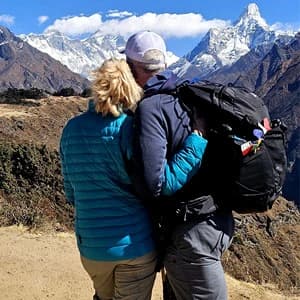
Nepal gateway trekking gave us a wonderful experience trekking the Gokyo circuit. We were very well looked after, from start to finish. Our guide Ramchandra...
Our family of four (two adults, 14yr old boy and 12yr old girl) were expertly chaperoned through a Gokyo Lakes trek by Nepal Gateway Trekking.
